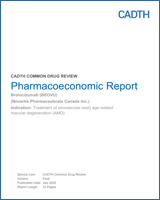CADTH undertook reanalyses to address limitations that included bevacizumab as a relevant comparator, applying equal treatment discontinuation, adjusting vision impairment costs, and applying a pooled, long-term treatment effect.
Using the CADTH base-case reanalyses, brolucizumab would not be considered cost-effective treatment at a willingness-to-pay (WTP) threshold of $50,000 per quality-adjusted life-year (QALY). The probability of brolucizumab being considered the most cost-effective intervention was 0% at a threshold of $50,000 per QALY (and even at a threshold of $100,000 per QALY). Price reductions can improve the cost-effectiveness of brolucizumab in patients with neovascular age-related macular degeneration (nAMD). At a WTP threshold of $50,000 per QALY, a respective price reduction of 85% is required for brolucizumab to be considered cost-effective compared to bevacizumab. No price reduction would be required for brolucizumab if bevacizumab was unavailable as a treatment option.
While some uncertainties remain in the model, it is highly unlikely that brolucizumab would be considered a cost-effective intervention relative to bevacizumab based on the efficacy estimates and price submitted by the sponsor.
Funding: CADTH receives funding from Canada’s federal, provincial, and territorial governments, with the exception of Quebec.
Disclaimer: The information in this document is intended to help Canadian health care decision-makers, health care professionals, health systems leaders, and policy-makers make well-informed decisions and thereby improve the quality of health care services. While patients and others may access this document, the document is made available for informational purposes only and no representations or warranties are made with respect to its fitness for any particular purpose. The information in this document should not be used as a substitute for professional medical advice or as a substitute for the application of clinical judgment in respect of the care of a particular patient or other professional judgment in any decision-making process. The Canadian Agency for Drugs and Technologies in Health (CADTH) does not endorse any information, drugs, therapies, treatments, products, processes, or services.
While care has been taken to ensure that the information prepared by CADTH in this document is accurate, complete, and up-to-date as at the applicable date the material was first published by CADTH, CADTH does not make any guarantees to that effect. CADTH does not guarantee and is not responsible for the quality, currency, propriety, accuracy, or reasonableness of any statements, information, or conclusions contained in any third-party materials used in preparing this document. The views and opinions of third parties published in this document do not necessarily state or reflect those of CADTH.
CADTH is not responsible for any errors, omissions, injury, loss, or damage arising from or relating to the use (or misuse) of any information, statements, or conclusions contained in or implied by the contents of this document or any of the source materials.
This document may contain links to third-party websites. CADTH does not have control over the content of such sites. Use of third-party sites is governed by the third-party website owners’ own terms and conditions set out for such sites. CADTH does not make any guarantee with respect to any information contained on such third-party sites and CADTH is not responsible for any injury, loss, or damage suffered as a result of using such third-party sites. CADTH has no responsibility for the collection, use, and disclosure of personal information by third-party sites.
Subject to the aforementioned limitations, the views expressed herein are those of CADTH and do not necessarily represent the views of Canada’s federal, provincial, or territorial governments or any third-party supplier of information.
This document is prepared and intended for use in the context of the Canadian health care system. The use of this document outside of Canada is done so at the user’s own risk.
This disclaimer and any questions or matters of any nature arising from or relating to the content or use (or misuse) of this document will be governed by and interpreted in accordance with the laws of the Province of Ontario and the laws of Canada applicable therein, and all proceedings shall be subject to the exclusive jurisdiction of the courts of the Province of Ontario, Canada.

